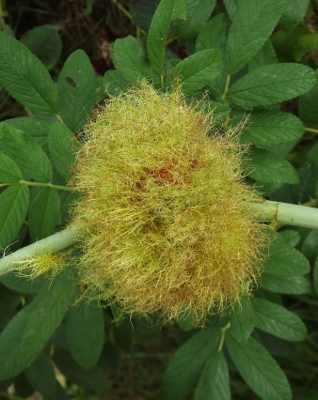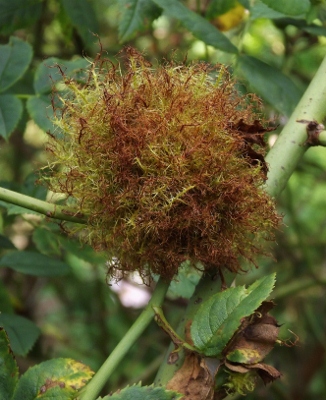 Pest and Life Cycle – (Diplolepsis rosae) The Mossy Rose Gall Wasp are small dark wasps that emerge from the old galls in late winter (April to May) as the weather turns warmer. There are few males produced and the females lay eggs for about 3 weeks in the dormant buds of specific roses. When the larvae hatch they feed on the buds, causing them to distort and grow large galls. The larvae live within the gall feeding, pupating the following year. There is one generation per year.
Pest and Life Cycle – (Diplolepsis rosae) The Mossy Rose Gall Wasp are small dark wasps that emerge from the old galls in late winter (April to May) as the weather turns warmer. There are few males produced and the females lay eggs for about 3 weeks in the dormant buds of specific roses. When the larvae hatch they feed on the buds, causing them to distort and grow large galls. The larvae live within the gall feeding, pupating the following year. There is one generation per year.
Symptoms – The primary symptoms are large (up to 4 inches wide) mossy galls commonly known as Robin’s Pincushions or  Bedeguar (Persian for ‘wind-brought’) Galls. These are usually located on the stems and may be yellowish-green to rose in colour, fading to brown. The galls start appearing from June to July.
Bedeguar (Persian for ‘wind-brought’) Galls. These are usually located on the stems and may be yellowish-green to rose in colour, fading to brown. The galls start appearing from June to July.
Management – Although the galls look rather ominous, they tend to do very little physical damage to the rose, although in severe cases the stem portion above the gall may decline or die-back. Organic pesticides are ineffective as the gall serves to protect the larvae inside, so the only viable management practice is the physical removal and disposal of the galls as they appear.
Prevention – This wasp species tends to target only species (such as R. canina) roses, Rosa rugosa and some old garden roses – rarely affecting modern hybrids. So your best prevention is to avoid planting the target species.



